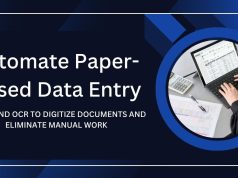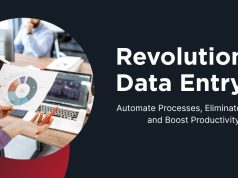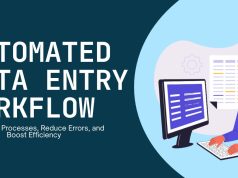Manual data entry is one of the biggest time drains in modern business. Employees spend countless hours copying information between spreadsheets, updating databases, and transferring data from one system to another. This repetitive work not only wastes valuable time but also introduces human error into critical business processes.
Python data entry automation offers a powerful solution to this problem. By leveraging Python’s extensive libraries and straightforward syntax, businesses can automate routine data tasks, reduce errors, and free up employees to focus on more strategic work. Whether you’re dealing with customer records, inventory management, or financial data, Python can streamline your workflows and boost productivity.
This guide will walk you through the fundamentals of automating data entry with Python, from basic concepts to practical implementation strategies. You’ll learn which tasks are best suited for automation, discover essential Python libraries, and see real-world examples that you can adapt for your own needs.
Why Automate Data Entry with Python?
Python has become the go-to language for data automation due to its versatility and rich ecosystem of libraries. Unlike other programming languages that require extensive setup and complex syntax, Python allows you to build automation scripts quickly and efficiently.
The benefits of Python data entry automation extend far beyond time savings. Automated processes eliminate human error, ensure data consistency, and can run 24/7 without supervision. This reliability is particularly valuable for businesses that handle large volumes of data or need to maintain strict accuracy standards.
Python’s extensive library ecosystem makes it particularly well-suited for data tasks. Libraries like pandas handle data manipulation, openpyxl works with Excel files, and selenium automates web-based data entry. This ecosystem means you rarely need to build solutions from scratch.
Common Data Entry Tasks Perfect for Python Automation
Before diving into implementation, it’s important to identify which data entry tasks will benefit most from automation. Not every data process is a good candidate for automation, but certain patterns emerge as ideal targets.
File Format Conversions
Converting data between different file formats is one of the most straightforward automation opportunities. Python can easily transform CSV files into Excel spreadsheets, extract data from PDFs, or convert databases into JSON format. These conversions often require specific formatting rules that Python can apply consistently every time.
Database Updates and Synchronization
Keeping multiple databases in sync manually is both time-consuming and error-prone. Python can automatically update records across different systems, ensuring that customer information, inventory levels, or financial data remain consistent across all platforms.
Web Form Submission
Many businesses still rely on web-based forms for data entry, especially when dealing with external systems or legacy applications. Python’s web automation capabilities can fill out these forms automatically using data from your existing systems.
Data Validation and Cleaning
Raw data often contains inconsistencies, duplicates, or formatting errors that need correction before use. Python excels at identifying and fixing these issues automatically, applying validation rules and standardizing formats across large datasets.
Essential Python Libraries for Data Entry Automation
Success with Python data entry automation depends largely on choosing the right libraries for your specific needs. Each library serves different purposes and excels in particular scenarios.
Pandas for Data Manipulation
Pandas is the cornerstone of most Python data automation projects. This library provides powerful data structures and tools for reading, manipulating, and writing data in various formats. Pandas can handle everything from simple CSV operations to complex data transformations involving multiple datasets.
The library’s DataFrame structure makes it easy to work with tabular data, while its built-in functions handle common tasks like filtering, grouping, and merging datasets. For most data entry automation projects, pandas will be your primary tool for processing and transforming information.
OpenPyXL for Excel Integration
Many businesses still rely heavily on Excel for data storage and analysis. OpenPyXL allows Python to read from and write to Excel files directly, maintaining formatting and formulas while automating data updates. This library is particularly valuable when you need to preserve existing Excel structures while updating content programmatically.
Selenium for Web Automation
When your data entry tasks involve web-based systems, Selenium provides the automation capabilities you need. This library can control web browsers programmatically, filling out forms, clicking buttons, and navigating between pages just as a human user would.
Selenium is particularly useful for businesses that need to interact with multiple web-based systems or update cloud applications that don’t offer API access. While web automation can be more complex than file-based operations, it opens up automation possibilities for almost any web-based data entry task.
SQLAlchemy for Database Operations
For businesses with substantial database operations, SQLAlchemy provides a powerful Python interface for working with various database systems. This library abstracts away many of the complexities of database programming while still providing full control over your data operations.
Building Your First Python Data Entry Automation Script
Getting started with Python data entry automation doesn’t require advanced programming skills. Most automation scripts follow similar patterns and can be adapted for different use cases.
Planning Your Automation Project
Before writing code, clearly define what your automation should accomplish. Identify the data sources, specify the transformations needed, and determine the output format. This planning phase will guide your library selection and script structure.
Consider the frequency of your automation needs as well. One-time data migrations require different approaches than daily automated updates. Understanding these requirements upfront will help you build more effective solutions.
Error Handling and Logging
Robust automation scripts include proper error handling and logging capabilities. Data sources can change unexpectedly, files might be missing, or network connections could fail. Your scripts should anticipate these scenarios and respond appropriately.
Implementing comprehensive logging allows you to monitor your automation processes and quickly identify issues when they arise. This monitoring becomes particularly important as you scale up your automation efforts.
Testing and Validation
Never deploy automation scripts without thorough testing. Start with small datasets and verify that your results match expectations. Build in validation checks that compare automated results against known good data when possible.
Consider creating test environments that mirror your production systems but use sample data. This approach allows you to verify your automation logic without risking damage to important business data.
Advanced Python Data Entry Automation Techniques
Once you’ve mastered basic automation concepts, several advanced techniques can make your scripts more powerful and reliable.
Parallel Processing for Large Datasets
When dealing with substantial amounts of data, parallel processing can significantly reduce execution time. Python’s multiprocessing library allows you to distribute work across multiple CPU cores, making your automation scripts much faster.
This technique is particularly valuable for operations that can be divided into independent tasks, such as processing multiple files or updating separate database tables.
API Integration
Many modern systems offer APIs that provide more reliable alternatives to web scraping or file-based data exchange. Learning to integrate with APIs can make your automation scripts more robust and maintainable.
APIs typically provide structured data access with built-in error handling and rate limiting. While initial setup might be more complex than file-based approaches, API integration often proves more reliable for long-term automation solutions.
Scheduling and Monitoring Automation
Production automation systems need reliable scheduling and monitoring capabilities. Python scripts can be scheduled using system tools like cron on Unix systems or Task Scheduler on Windows. For more complex scenarios, dedicated workflow management tools like Apache Airflow provide sophisticated scheduling and monitoring features.
Proper monitoring includes not just error detection but also performance tracking and data quality validation. These capabilities become essential as your automation systems grow in complexity and importance.
Overcoming Common Python Data Entry Automation Challenges
Even well-planned automation projects encounter obstacles. Understanding common challenges and their solutions can save significant time and frustration.
Handling Data Format Variations
Real-world data rarely conforms to perfect standards. Dates might be formatted differently across systems, text fields could contain unexpected characters, or numeric data might include currency symbols. Building flexible parsing logic that handles these variations is crucial for robust automation.
Regular expressions and pandas’ built-in data cleaning functions can address many formatting inconsistencies automatically. For more complex scenarios, consider building lookup tables or validation rules that standardize data as it’s processed.
Managing System Dependencies
Automation scripts often depend on external systems that might be unavailable or slow to respond. Building retry logic and graceful degradation into your scripts helps maintain reliability even when external dependencies have issues.
Consider implementing circuit breaker patterns that temporarily disable problematic integrations while continuing to process data from reliable sources.
Scaling Automation Solutions
Successful automation projects often grow beyond their original scope. What starts as a simple file conversion might evolve into a comprehensive data integration system. Planning for this growth from the beginning helps avoid architectural limitations later.
Modular script design, proper configuration management, and comprehensive documentation become increasingly important as automation systems grow in complexity.
Transform Your Data Processes with Python Automation
Python data entry automation represents a significant opportunity for businesses looking to improve efficiency and reduce errors in their data processes. The combination of Python’s accessibility and powerful libraries makes automation achievable even for organizations with limited programming resources.
Start small by identifying repetitive data entry tasks that consume significant time or are prone to errors. Build simple automation scripts for these processes and gradually expand your capabilities as you gain experience and confidence.
The investment in learning Python data entry automation pays dividends quickly. Most organizations see immediate time savings and error reductions, while the skills and infrastructure developed for initial projects enable increasingly sophisticated automation solutions over time.










